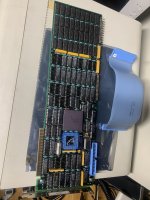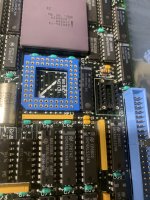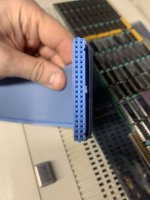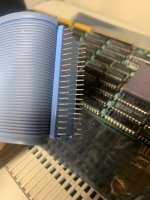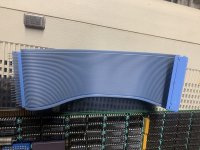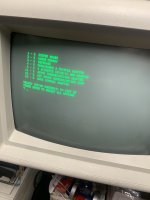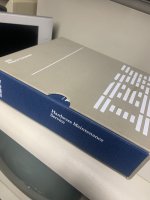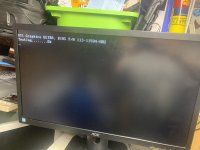Mike1978
Experienced Member
I’ve recently acquired an Intel Inboard 386/PC it’s been running great, I made a 4mb daughterboard thanks to others in this forum.
I swapped out the oscillator from 32MHz to 40Mhz and adding a socket in the process.
I put a Cyrix 486 cx486drx2 20/40 CPU on the board and a DLC 487 FPU.
It’s been running in my 5150 for the best part of a month and for a good few weeks with the new Oscillator.
I’ve been looking to upgrade my XT IDE and on running xtidecfg I hit an issue where the flash failed saying it wasn’t right. I took the cable from the inboard to access the Xtide to remove the label and check the rom type, did so and put everything back then black screen.
Noting I’d removed and unplugged the cable many times and the card as a whole also many times without issue. I know these things aren’t meant to be moved about a lot but getting the right combination and experimenting to get it right led to some tinkering and moving about. That and the limitation of 5 isa slots in the 5150.
The crux of my issue is now the inboard will no longer boot.
Replaced the original cpu and the 5150 board starts up, but put the inboard into either 5150 and a whole lot of nothing, no beeps just the psu powering up.
As there are no moving parts and only the parasitic cable to the CPU slot I figured I’d check the cable for potential faults.
I beeped out each hole in the idc connector to the dip pins that go to the cpu socket. 40 holes / pins and each matched up accordingly.
I’m at a loss as to what may have gone bad or if there’s any hope of ressurection, it’s a rare card and one I’d hope for many years of service to come.
So putting a plea out for anyone who knows how to help or what to try next.
I have swapped back the original oscillator and put a standard 16mhz Intel cpu back in the card and removed the fpu all to no avail tried with and without the daughterboard.
I have very little in terms of diagnosis beyond a standard multi-meter and probably not many more skills besides other than relying on the goodwill of others to throw me a life line.
Please help!
Mike
I swapped out the oscillator from 32MHz to 40Mhz and adding a socket in the process.
I put a Cyrix 486 cx486drx2 20/40 CPU on the board and a DLC 487 FPU.
It’s been running in my 5150 for the best part of a month and for a good few weeks with the new Oscillator.
I’ve been looking to upgrade my XT IDE and on running xtidecfg I hit an issue where the flash failed saying it wasn’t right. I took the cable from the inboard to access the Xtide to remove the label and check the rom type, did so and put everything back then black screen.
Noting I’d removed and unplugged the cable many times and the card as a whole also many times without issue. I know these things aren’t meant to be moved about a lot but getting the right combination and experimenting to get it right led to some tinkering and moving about. That and the limitation of 5 isa slots in the 5150.
The crux of my issue is now the inboard will no longer boot.
Replaced the original cpu and the 5150 board starts up, but put the inboard into either 5150 and a whole lot of nothing, no beeps just the psu powering up.
As there are no moving parts and only the parasitic cable to the CPU slot I figured I’d check the cable for potential faults.
I beeped out each hole in the idc connector to the dip pins that go to the cpu socket. 40 holes / pins and each matched up accordingly.
I’m at a loss as to what may have gone bad or if there’s any hope of ressurection, it’s a rare card and one I’d hope for many years of service to come.
So putting a plea out for anyone who knows how to help or what to try next.
I have swapped back the original oscillator and put a standard 16mhz Intel cpu back in the card and removed the fpu all to no avail tried with and without the daughterboard.
I have very little in terms of diagnosis beyond a standard multi-meter and probably not many more skills besides other than relying on the goodwill of others to throw me a life line.
Please help!
Mike

